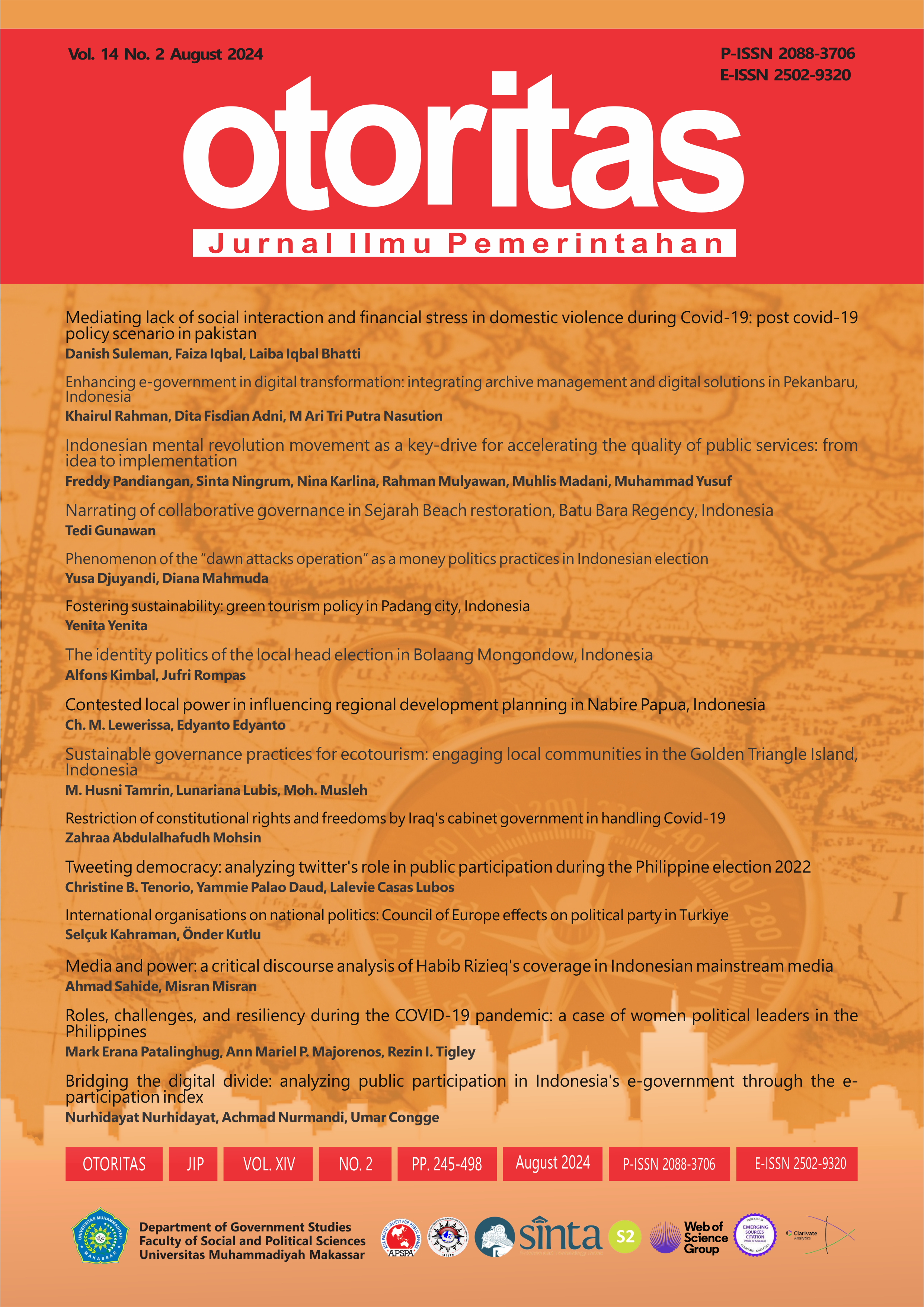Tweeting democracy: analyzing twitter's role in public participation during the Philippine election 2022
DOI:
https://doi.org/10.26618/ojip.v14i2.14590Keywords:
twitter, social network analysis, sentiment analysis, electionAbstract
This study displays Twitter's relevance in collecting sentiments and evaluating social networks, notably in election processes. This study examines 10,000 tweets on the 2022 Philippine presidential election, gathered during the key week of May 9–13, 2022, to show Twitter's influence in molding the public conversation. The study found the most popular hashtags, including #halalan2022 and #eleksyon2022, highlighting their importance in the digital discussion around the election. A thorough social network study established eight key communities, demonstrating a strong connection among Filipino netizens during election-related debates. Among these, noteworthy people such as @RexelBartolome and @daywreckoning, as well as the news site @ABSCBNEWS, emerged as essential nodes, demonstrating their influence in information dissemination. Sentiment analysis of the tweets revealed a mostly neutral public mood toward the election, with frequent phrases such as "martial law" and "never again" indicating the discourse's underlying themes. This study examines Twitter as a valuable instrument for political analysis and advocates for a more sophisticated method of picking tweets that truly reflect community attitudes. Future studies should look beyond pre-election times to provide a complete picture of online debate, using Twitter's API for easy data gathering and analysis. This study closes a fundamental gap in understanding social media dynamics in the Philippines, providing insights for academic and practical applications in political communication.
References
Agrawal, A., & Hamling, T. (2021). Sentiment Analysis of Tweets to Gain Insights into the 2016 US Election. Columbia Undergraduate Science Journal, 11. https://doi.org/10.52214/cusj.v11i.6359
Annett, M., & Kondrak, G. (2008). A Comparison of Sentiment Analysis Techniques: Polarizing Movie Blogs. In Lecture notes in computer science (pp. 25–35). https://doi.org/10.1007/978-3-540-68825-9_3
Bansal, B., & Srivastava, S. (2018). On predicting elections with hybrid topic-based sentiment analysis of tweets. Procedia Computer Science, 135, 346–353. https://doi.org/10.1016/j.procs.2018.08.183
Benvenisti, E. (2018). Upholding Democracy Amid the Challenges of New Technology: What Role for the Law of Global Governance? European Journal of International Law, 29(1), 9–82. https://doi.org/10.1093/ejil/chy013
Boyd, D., Golder, S., & Lotan, G. (2010). Tweet, Tweet, Retweet: Conversational Aspects of Retweeting on Twitter. https://doi.org/10.1109/hicss.2010.412
Bridge, G., Flint, S. W., & Tench, R. (2021). A mixed-method analysis of the #SugarTax debate on Twitter. Public Health Nutrition, 24(11), 3537–3546. https://doi.org/10.1017/s1368980021000938
Burnap, P., Gibson, R., Sloan, L., Southern, R., & Williams, M. (2016). 140 characters to victory?: Using Twitter to predict the UK 2015 General Election. Electoral Studies, 41, 230–233. https://doi.org/10.1016/j.electstud.2015.11.017
Budiharto, W., & Meiliana, M. (2018). Prediction and analysis of Indonesia Presidential election from Twitter using sentiment analysis. Journal of Big Data, 5(1). https://doi.org/10.1186/s40537-018-0164-1
Castro, R., Kuffo, L., & Vaca, C. (2017). Back to #6D: Predicting Venezuelan states political election results through Twitter. https://doi.org/10.1109/icedeg.2017.7962525
Cheong, France (2011). Social Media Data Mining: A Social NetworkAnalysis Of Tweets During The 2010-2011Australian Floods. Association for Information Systems AIS Electronic Library (AISeL). PACIS 2011 Proceedings
Daga, R. R. M. (2017). Social Network Analysis of Tweets on Typhoon during Haiyan and Hagupit. Proceedings of the 8th International Conference on Computer Modeling and Simulation. https://doi.org/10.1145/3036331.3036345
Drakopoulos, G., Giannoukou, I., Mylonas, P., & Sioutas, S. (2020). A Graph Neural Network For Assessing The Affective Coherence Of Twitter Graphs. https://doi.org/10.1109/bigdata50022.2020.9378492
Drakopoulos, G., Kanavos, A., Paximadis, K., Ilias, A., Makris, C., & Mylonas, P. (2020). Computing Massive Trust Analytics for Twitter using Apache Spark with Account Self-assessment. https://doi.org/10.5220/0010214104030414
Esteves, P. (2016, May 17). Social media changes landscape of Phl elections. Retrieved from https://www.philstar.com/headlines/2016/05/13/1583095/
Ferdiana, R., Fajar, W., Dwi, D., Sekar, A., & Jatmiko, F. (2019). Twitter Sentiment Analysis in Under-Resourced Languages using Byte-Level Recurrent Neural Model. International Journal of Advanced Computer Science and Applications/International Journal of Advanced Computer Science & Applications, 10(8). https://doi.org/10.14569/ijacsa.2019.0100815
Galarnyk, M. (2019, November 29). Accessing Data from Twitter API using R - Michael Galarnyk - Medium. Medium. https://medium.com/@GalarnykMichael/accessing-data-from-twitter-api-using-r-part1-b387a1c7d3e
Ghermaoui, A. (2015). Facebook during American election Campaigns: a tool for mobilization, fundraising and voting influence. Traduction Et Langues, 14(2), 41–51. https://doi.org/10.52919/translang.v14i2.759
Harkan, A. A., Fatimah, A. N., & Erawaty, D. P. (2021). Communication Network Analysis of Negative Campaigns on #BapakHoaxNasional in the 2019 Presidential Election. Advances in Social Science, Education and Humanities Research/Advances in Social Science, Education and Humanities Research. https://doi.org/10.2991/assehr.k.210531.002
Haupt, M. R., Jinich-Diamant, A., Li, J., Nali, M., & Mackey, T. K. (2021). Characterizing twitter user topics and communication network dynamics of the “Liberate” movement during COVID-19 using unsupervised machine learning and social network analysis. Online Social Networks and Media, 21, 100114. https://doi.org/10.1016/j.osnem.2020.100114
Jungherr, A. (2015). Twitter use in election campaigns: A systematic literature review. Journal of Information Technology & Politics, 13(1), 72–91. https://doi.org/10.1080/19331681.2015.1132401
Kaplan, A. M., & Haenlein, M. (2012). Social media: back to the roots and back to the future. Journal of Systems and Information Technology, 14(2), 101–104. https://doi.org/10.1108/13287261211232126
Kasuya, Y., & Calimbahin, C. A. A. (2024). Democratic backsliding in the Philippines: Are voters becoming illiberal? Asian Journal of Comparative Politics, 9(1), 121-132. https://doi.org/10.1177/20578911221136263
Kwak, H., Lee, C., Park, H., & Moon, S. (2010). What is Twitter, a social network or a news media? https://doi.org/10.1145/1772690.1772751
Kushal D, Lawrence S, Pennock DM (2003). Mining the peanut gallery: Opinion extraction and semantic classification of product reviews. In: Proceedings of international conference on world wide web (WWW2003). 2003.
M, A., & Ravikumar, P. (2015). Survey: Twitter data Analysis using Opinion Mining. International Journal of Computer Applications, 128(5), 34–36. https://doi.org/10.5120/ijca2015906553
Macaraeg, P. (2022, February 9). Study finds signs of ‘networked political manipulation’ on social media. Retrieved from https://www.rappler.com/nation/elections/study-finds-sign-networked-political-manipulation-social-media-digital-public-pulse-project/.
Metzgar, E., & Maruggi, A. (2009). Social Media and the 2008 U.S. Presidential Election. https://fralincm.files.wordpress.com/2011/06/socialmedia_08election.pdf
Mezzanzanica, M., Mercorio, F., Cesarini, M., Moscato, V., & Picariello, A. (2018). GraphDBLP: a system for analysing networks of computer scientists through graph databases. Multimedia Tools and Applications, 77(14), 18657–18688. https://doi.org/10.1007/s11042-017-5503-2
Mislove, A., Lehmann, S., Ahn, Y. Y., Onnela, J. P., & Rosenquist, J. (2021). Understanding the Demographics of Twitter Users. Proceedings of the . . . International AAAI Conference on Weblogs and Social Media/Proceedings of the International AAAI Conference on Weblogs and Social Media, 5(1), 554–557. https://doi.org/10.1609/icwsm.v5i1.14168
Muzaki, A., & Witanti, A. (2021). Sentiment Analysis Of The Community In The Twitter To The 2020 Election In Pandemic Covid-19 By Method Naive Bayes Classifier. Jurnal Teknik Informatika, 2(2), 101–107. https://doi.org/10.20884/1.jutif.2021.2.2.51
Nguyen, T. H., Fisichella, M., & Rudra, K. (2024). A Trustworthy Approach to Classify and Analyze Epidemic-Related Information from Microblogs. IEEE Transactions on Computational Social Systems, 1–13. https://doi.org/10.1109/tcss.2024.3391395
Paek, H. J., Baek, H., Lee, S., & Hove, T. (2018). Electronic Cigarette Themes on Twitter: Dissemination Patterns and Relations with Online News and Search Engine Queries in South Korea. Health Communication, 35(1), 1–9. https://doi.org/10.1080/10410236.2018.1536952
Pak, A., & Paroubek, P. (2010). Twitter as a Corpus for Sentiment Analysis and Opinion Mining. https://www.researchgate.net/profile/Patrick_Paroubek2/publication/220746311_Twitter_as_a_Corpus_for_Sentiment_Analysis_and_Opinion_Mining/links/0deec52bb2a4cc37f8000000.pdf
Park, J., & Tsou, M. H. (2020). Analyzing Public Discourse on Social Media With A Geographical Context: A Case Study of 2017 Tax Bill. https://doi.org/10.1145/3400806.3400809
Quitzon, Japhet (2021, March 7). Social Media Misinformation and the 2022 Philippine Elections. Retrieved from https://www.csis.org/blogs/new-perspectives-asia/social-media-misinformation-and-2022-philippine-elections.
Ramteke, J., Shah, S., Godhia, D., & Shaikh, A. (2016). Election result prediction using Twitter sentiment analysis. https://doi.org/10.1109/inventive.2016.7823280
Rauniyar, K., Poudel, S., Shiwakoti, S., Thapa, S., Rashid, J., Kim, J., Imran, M., & Naseem, U. (2023). Multi-Aspect Annotation and Analysis of Nepali Tweets on Anti-Establishment Election Discourse. IEEE Access, 11, 143092–143115. https://doi.org/10.1109/access.2023.3342154
Sanvictores, Benito V (2022, March 1). New media actors: alternative news sources. Retrieved from https://upd.edu.ph/new-media-actors-alternative-news-sources/.
Singh, P., Dwivedi, Y. K., Kahlon, K. S., Pathania, A., & Sawhney, R. S. (2020). Can twitter analytics predict election outcome? An insight from 2017 Punjab assembly elections. Government Information Quarterly, 37(2), 101444. https://doi.org/10.1016/j.giq.2019.101444
Soler, J. M., Cuartero, F., & Roblizo, M. (2012). Twitter as a Tool for Predicting Elections Results. https://doi.org/10.1109/asonam.2012.206
Stepanyan, K., Borau, K., & Ullrich, C. (2010). A Social Network Analysis Perspective on Student Interaction within the Twitter Microblogging Environment. https://doi.org/10.1109/icalt.2010.27
Suh, B., Hong, L., Pirolli, P., & Chi, E. H. (2010). Want to be Retweeted? Large Scale Analytics on Factors Impacting Retweet in Twitter Network. https://doi.org/10.1109/socialcom.2010.33
Tripathi, P., Vishwakarma, S. K., & Lala, A. (2015). Sentiment Analysis of English Tweets Using Rapid Miner. https://doi.org/10.1109/cicn.2015.137
Tumasjan, A., Sprenger, T., Sandner, P., & Welpe, I. (2010). Predicting Elections with Twitter: What 140 Characters Reveal about Political Sentiment. Proceedings of the . . . International AAAI Conference on Weblogs and Social Media/Proceedings of the International AAAI Conference on Weblogs and Social Media, 4(1), 178–185. https://doi.org/10.1609/icwsm.v4i1.14009
Yi, J., Nasukawa, T., Bunescu, R., & Niblack, W. (2004). Sentiment analyzer: extracting sentiments about a given topic using natural language processing techniques. https://doi.org/10.1109/icdm.2003.1250949
Downloads
Published
Issue
Section
License
The Editorial Team of Otoritas: Jurnal Ilmu Pemerintahan reserves the right to transfer the copyright of the article once it has been accepted and a decision has been made to publish it.
Department of Government Studies, Faculty of Social and Political Sciences, Universitas Muhammadiyah Makassar in collaboration with Muhammadiyah’s College Association of Government Studies (AIPPTM) and Asia Pacific Society for Public Affairs (APSPA) as the publisher of Otoritas: Jurnal Ilmu Pemerintahan holds the copyright of all articles published in this journal.
The Publisher holds the right to reproduce and distribute the article and author is not allowed to publish the same article published in this journal.
Statement of Authenticity and Manuscript Copyright can be downloaded: here
After filling in the statement letter, please send via e-mail: otoritas@unismuh.ac.id






